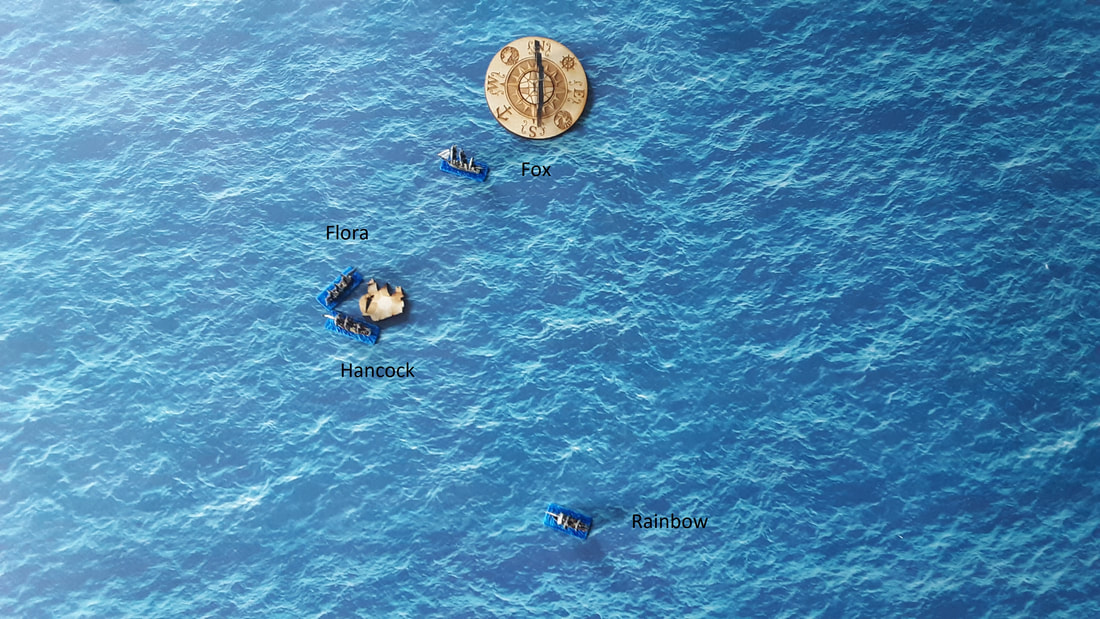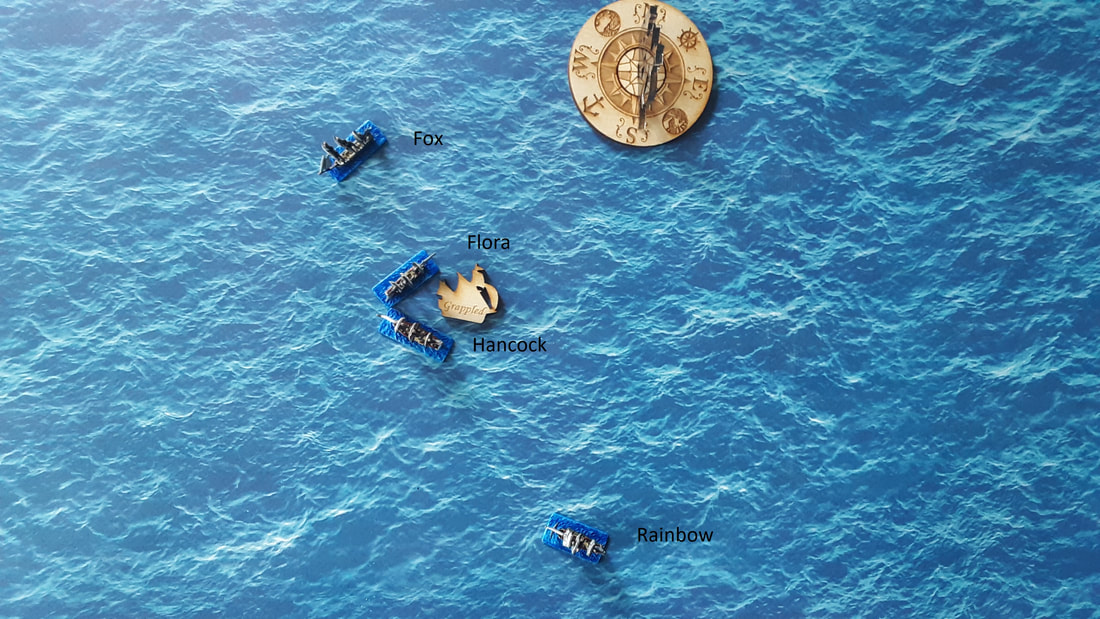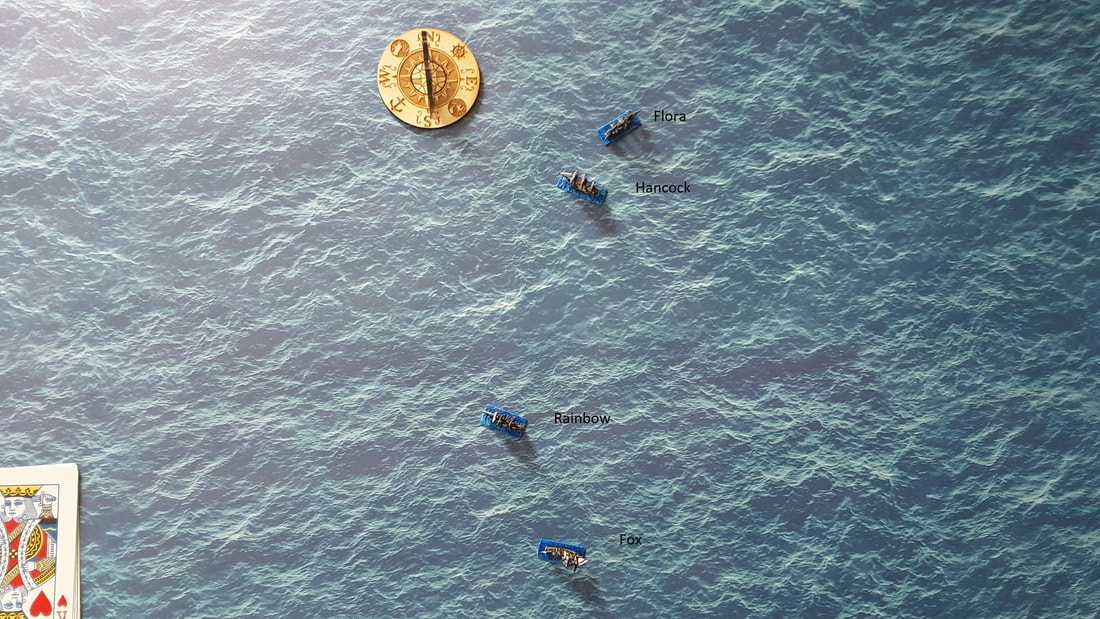|
1 March 1944
A sequential raid of Japanese aircraft and heavy cruisers at the Army’s landings on Manus Island in the Admiralties was beaten back. So said the official report from Rear Admiral William Fechteler to General Douglas MacArthur. In actuality, it was a near disaster. The day before Fechteler had landed elements of the First Cavalry on the island and they had made good progress. That morning more troops were being landed from three APDs and supplies were being ferried ashore at a frantic pace. Two DDs were on station providing gunfire support to the cavalrymen. Radar picked up an incoming swarm from Rabaul. Fighter control aboard USS San Diego vectored the 16 P-40s flying cover from New Guinea to intercept. Poor coordination between the Army Air Force flyers and the Navy gunners proved catastrophic. Fifteen Warhawks were shot down, five by “friendly” AA fire. However, the Japanese displayed their deteriorating pilot skill as well. Twenty-seven Betty bombers and a dozen Zero fighters swooped in on the packed harbor. Heavy, accurate AA fire and the doomed Warhawks shot down 11 Zeroes and 9 Bettys. The survivors dropped 20 bombs and 13 torpedoes and succeeded in getting only a single hit. It was a spectacular hit, however, penetrating three decks on the seaplane tender Curtiss to land in the depth charge magazine and rip the ship to tiny pieces. As the surviving planes swept over the land and out of sight, USS Barton signalled “Unidentified ships, 30,000 yards and closing!” They turned out to be IJN Tone and IJN Myoko who had crept up on the landing by using the shore to mask themselves from radar. Left with no choice, Admiral Fechteler ordered his covering force to charge the Japanese heavy cruisers, whose 8-inch main guns easily outranged the 5-inchers of the Americans. The ensuing gun battle saw the volume of American fire smother the two heavy cruisers. While the 8-inchers hit much harder, the rapid-fire 5-inchers hit exponentially more often, eventually turning both Japanese ships into infernos. The heavy fire did claim San Diego, sinking with no less than 10 heavy caliber hits and six hits by smaller guns. Four destroyers were also hit, two seriously, but gunnery honors went to USS Barton, the ship who gave first warning, which scored an unbelievable 21 hits on Myoko and 4 more on Tone. The landing was saved but McArthur was forced to divert USS Phoenix and two destroyers from protecting coastal traffic in New Guinea to replacing the losses sustained by Fechteler. As for the Japanese, they had thrown their last roll of the dice to support the infantry now doomed to destruction on Manus.
0 Comments
Cochrane, Nelson, and Jones (CNJ) is a set of rules for naval warfare in the Age of Sail, roughly 1700-1820. It works equally well with single ship actions and large fleet battles. The need for record-keeping is reduced from that traditionally required for such games by using tokens and by using a card-based movement sequence. On a ship’s roster only damage, current speed, and boarding parties need to be noted. The American frigates Fox and Hancock are running away from the small British 4th rate Rainbow. They are all hauling to the west northwest when another sail, the Flora, displaying Continental colors, appears fine off the port bow. The game begins with Flora 300 yards from Hancock, Fox 150 yards off Hancock’s starboard beam and Rainbow 200 yards astern of Hancock. Scenario specific rules are (1) that all ships must maintain course until Flora fires or approached within 40 yards of either American ship and (2) Flora must tack and close on the Americans at her best speed. For the move sequence, Fox draws a 9, Hancock a 5, Flora a 6, and Rainbow a King. Turn 1 Phase 1 Flora tacks in the first phase, turning into the wind. The other three continue straight as per the scenario. Turn 1 Phase 2 sees Flora complete her tack but with some sternboard, so she has lost a bit of seaway. She is now approaching Hancock on the opposite tack. Turn 1 Phases 3 and 4 see all four ships maintaining speed and course, men poised at battle stations. Flora is now nearly crossing bowsprits with Hancock. Turn 2 Phase 1 Card 1 is King of spades, Rainbow moves forward 55. Card 2 is 9 of diamonds, Fox moves forward 55. Card 3 is a 6 of clubs. Flora hauls down Continental colors, raises English colors, moves forward 60 and pours a raking broadside into the Hancock. Range is 20, odds are 12:11 (1:1) and the rolls are blue 5 and red 8 resulting in 4 hull and 2 rigging hits on Hancock. She also passes with 15mm of Hancock (nearest point) and rolls an 8 on the fouling table (not fouled). Fox and Hancock decide to hold their fire. Card 4 is 5 of spades. Hancock now moves to rake Flora. Unfortunately, she rolls a zero on the fouling table and her bowsprit becomes entangled in the mizzen of Flora. She lets go with her heavier, 12-pounder, broadside, at a range of only 30. Odds are 16:9 (3:2) blue 7 red 9 (+1) which results in 6 hull and 2 rigging. Turn 2 Phase 2 Card 1 is 5 of clubs. Hancock makes the decision to board Flora and attempts to grapple, succeeding with a roll of 8. Card 2 is King of clubs and Rainbow closes on the unengaged side of Hancock, moving forward 55. Card 3 is 6 of hearts. Flora attempts to ungrapple and unfoul but fails with both rolls. With a heart Flora’s battery is reloaded at the end of the phase. Last card is 9 of clubs. Fox wears 60 and fires at Flora but only rolls blue 8 and red 1. At a range of 30 that is only one hull. Flora returns fire and gets a much better blue 0 red 9 which results in 4 hull and a rigging. Flora and Hancock drift 10 downwind. Turn 2 Phase 3 Card 1 is 9 of hearts. Fox slows to just 30. Card 2 is 6 of diamonds. Flora manages to ungrapple (rolling a 9) but stays fouled (rolling a 4). She does let loose on Hancock, now at 10:11 (2:3), rolling blue 4 and red 4 which is one hull. She also sets a defensive boarding part of all sailors and marines. Card 3 is King of hearts. Rainbow moves forward 55 with a maximum deviation to try to close with Hancock. Card 4 is 5 of diamonds. Hancock throws another grapple and succeeds (8). She sets an offensive boarding party of all sailors and marines and three sections of gunners. Turn 2 Phase 4 Card 1 is the King of diamonds. Rainbow is finally up on Hancock, moving forward 40. Range is only 40 but the gunnery gods are not with the British. The heavy 18-pounder battery has odds of 18:11 (3:2) but roll blue 5 and red 0 for only one hull. The lighter 12-pounder battery does even worse, rolling blue 0 and red 0 for a miss. Hancock returns fire from its previously unengaged port battery, odds 11:13 (due to 3 gunners no longer at their guns) rolling blue 2 and red 3 for a single hull. Card 2 is 9 of spades. Fox inches forward 10, waiting for her guns to reload. Card 3 is 5 of hearts. Hancock fails to attach a second grapple (5). The final card is 6 of spades and Flora again ungrapples (9) but fails to unfoul (5). At the end of the turn the boarders are away! Hancock has 16 points against 8 for Flora. Roll is a 4. The attacker seizes a section of deck with losses of 2 crew sections for the attacker (Hancock) and 3 for the defender (Flora). Turn 3 Phase 1 Card 1 is a 5 of diamonds. Hancock now has a 14:6 advantage in melee but rolls a 3 and gets a stalemate, losing 1 more crew section but Flora loses 2. Card 2 is a king of diamonds. Rainbow, at barely 30 range fires into Hancock inflicting 3 hull and a rigging from her 18s and another hull from the 12s. Hancock replies with a ragged broadside and also gets one hull. Card 3 is a 9 of diamonds and Fox wears 15, moves forward 40 and pours her broadside in a bow rake of Rainbow, rolling a blue 8 and red 2. The light 9-pounders only score two hull. The last card is 6 of hearts. Flora desperately orders all gunners to form into a reinforcing boarding party (this will take two phases). Her existing party fights a bloody stalemate, rolling 5(-2) resulting in 3 crew lost for the attacker but 2 more sections lost for Flora. Turn 3 Phase 2 Card 1 is 5 of spades. Hancock, despite an 11:2 advantage rolls a 0 and gets another stalemate, losing two more sections. But Flora loses one, leaving her with a single section in melee. Card 2 is a 6 of diamonds. Flora rolls a 4 (+4) which ends the melee (Hancock takes the last two sections of deck AND the last crew section of Flora is casualties. Hancock loses one more crew section, for a total loss of 8 crew sections (2 gunners, 5 marines, and a sailor). Card 3 is a King of hearts. Rainbow tacks, bringing her port broadside full on to Fox at a range of only 40. Between both batteries she inflicts another 4 hull on Fox. Because the card was a heart, she reloads. Card 4 is a 9 of clubs. Fox moves forward 60. She also recovers her maneuver chip. Turn 3 Phase 3 Card 1 is King of spades. Rainbow attempts to complete her tack but rolls a 0 and is in irons! Special damage to the Rigging is a 62 – main topmast falls to starboard and obscures the battery. She is pushed backward 45 (55 minus 10 for dragging a mast) which puts her in range to fire at Fox again at a range of 40, causing a total of 4 more hull and a rigging. Card 2 is 5 of hearts. Hancock forms a prize crew of 2 sailor sections and a marine section on Flora. She attempts to unfoul and fails (7). Card 3 is a 9 of hearts. Fox moves forward 60 and reloads with chain shot. Flora gets no action for her card as the prize crew is organizing. Turn 3 Phase 4 Card 1 is 6 of spades. Again, Flora takes no action. Her prize crew will be organized at the end of this phase. Card 2 is 9 of spades. Fox wears 70 and takes Rainbow in a stern rake at only 70 range with dismantling shot. Her battered 9-pounders though are only 6:13 and she gets a red 0, only one rigging. Card 3 is a 5 of clubs and Hancock lets loose at Rainbow at range 130. However, her blue 8 is an outright miss. She again fails to unfoul (7). Card 4 is a King of clubs. Rainbow tries again to complete the tack and fails again with a roll of 1. This time she rolls a 95 and the entire mizzen mast falls, obscuring the port battery. She does cut away the starboard debris. Turn 4 Phase 1 Card 1 is a 5 of clubs. Hancock finally unfouls (2) but fails to ungrapple (0). She fires again at Rainbow, now with more gunners and rolls better, blue 3 and red 5 firing high and causing two rigging boxes. Card 2 is a 6 of hearts and Flora ungrapples (8) and gets under way, moving forward 25. Card 3 is 9 of hearts. Fox moves forward 60 and fires chain again at Rainbow, range 70, stern rake, but 1:3 odds (6:13), blue 7 and red 6 is one more rigging. Card 4 is King of hearts. Rainbow falls off and fires at Hancock, range 130. She rolls two 0’s and inflicts no damage; she does manage to cut away the fallen mizzen. Turn 4 Phase 2 Card 1 is King of diamonds. Rainbow, having reloaded with a heart at the end of the previous phase, now wears 40 (full speed) and fires at Fox, range 110, a stern rake. The dice gods, so pointedly absent last phase, return. With a blue 5 and red 9 her heavy battery scores 10 hull and 3 rigging and the upper battery gets another 3 hull and one rigging. Fox needs to roll twice on the Special Hull Damage table. First is 07 which is a mast. Rolling then on the Special Damage to Masts and Rigging is a 27 bringing down the foretopgallant which falls clear off the starboard side. The second Special Hull Damage roll is a 28, rudder damaged. The last three cards each of the ships simply moves forward. This ends the game. (Picture is of the fateful rake). Epilogue. Flora had the misfortune of being fouled by the larger Hancock. This was compounded by hoping to detach and regain maneuver over being fully committed to the boarding action. Because Hancock committed so many crew to boarding, on the other hand, she was left to hope Fox could divert the much larger Rainbow. Fox did an admirable job dancing about, but her light guns could do little against the small 2-decker. Rainbow, in the end, was done in by poor seamanship, losing two masts in her abortive tack. Rainbow’s gunnery was erratic but averaged, in the end, to devastating damage on Fox and significant damage to Hancock.
Played a sharp little naval action entirely by email. A small Russian naval squadron, led by the 100-gun Saratov, with two 74s, engaged a Swedish squadron of a 70, 2 62s, and a 540 gun frigate. Photos are from the climactic 8th turn, where all ships were engaged, the two lines passing each other at from 1-3 cables apart. The frigate rakes the massive first rate, but rolls poorly, dooming the Swedes, who were then forced to withdraw with both their flagship and one of the 62s at over 75% damage.
We played a representation of the Battle of Empress Augusta Bay, of November 1-2, 1943. While the actual battle was a mass of confusion with ships of both sides colliding with each other in the dark and shooting at friends, ours was a much more controlled scenario exploring “what if” the American plan was carried out to perfection.
The Japanese under Admiral Unlucky Tomiachi approached as they had historically with the two heavy cruisers Myoko and Haguro in line ahead flanked by two columns each of a light cruiser leading and three destroyers. The Americans under Admiral Just-Follow-the-Plan Caccamerrill and Close AtSpeed Burkox started in line ahead across the Japanese “T” with four destroyers then four “light” cruisers and four trailing destroyers. The Japanese also had two scout planes intended to drop flares. The battle began with some tentative radar contacts and a flash of anti-aircraft fire as gunners on the Cleveland and Claxton opened up on the two scouts. The AA gunners were met by spectacular success as both Suisei exploded in mid-air, foreshadowing the rest of the game. Admiral Tomiachi, acting on imperfect information, split three destroyers to his right (west) and turned the rest of the squadron hard left, intending to match the American gun line with his own four cruisers, screened by the three eastern-most destroyers. Admirals Caccamerrill and Burkox executed the historical plan with the lead four destroyers continuing forward and the rest of the command reversing course. The entire Japanese squadron opened fire on Cleveland, scoring hits and starting fires but not knocking her out. The Americans opened fire with the few ships who had made radar contact, with a couple minor hits. Both squadrons now established on their new courses, and with plenty of gun flashes to fire at, the battle was joined in earnest. The Japanese launched torpedoes from every ship but were quickly smothered by the American shells. Myoko was first to be crippled, then Sendai and, one by one, the destroyers. The return fire was less effective, causing minor damage to Denver, Ausburne, and Foote. Tomiachi ordered a withdrawal only 5 minutes after launching torpedoes and ordered all ships to make smoke. But it was too late. The Americans had full acquisition by radar and, at ranges from 5000-9000 yards, simply smothered the Japanese fleet. Deftly turning into the torpedo salvoes only Ausburne was hit out of the nearly 70 Long Lances launched, and that hit proved to be a dud. Every Imperial ship was sunk with only Cleveland and Foote being damaged enough to be forced to leave the landing area the next day. With no confusion, unerring radar, and perfect execution, the Americans in the game won an overwhelming victory denied the actual Americans 75 years before. No matter, historically the Japanese had been bloodied sufficiently that they never again made a significant sortie in the Solomons. Game was played using 1:2400 ships and Sbase3 computer-assisted rules. |
AuthorDiatribes are simply often humorous recountings of the games played by the Long Island Irregulars. We play with toy soldiers and are unabashedly happy to have never lost this part of our childhoods.. Archives
April 2024
Categories
All
|













 RSS Feed
RSS Feed